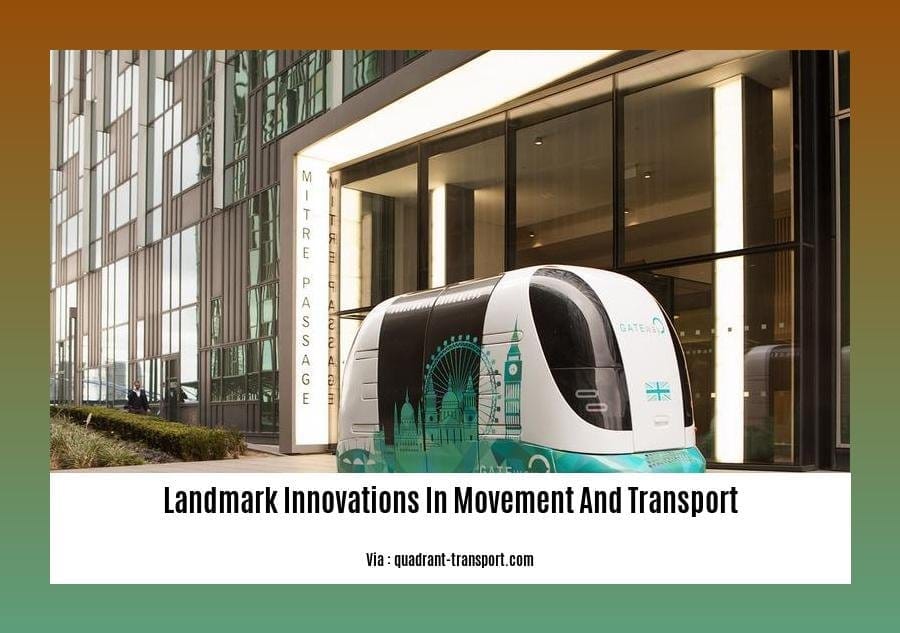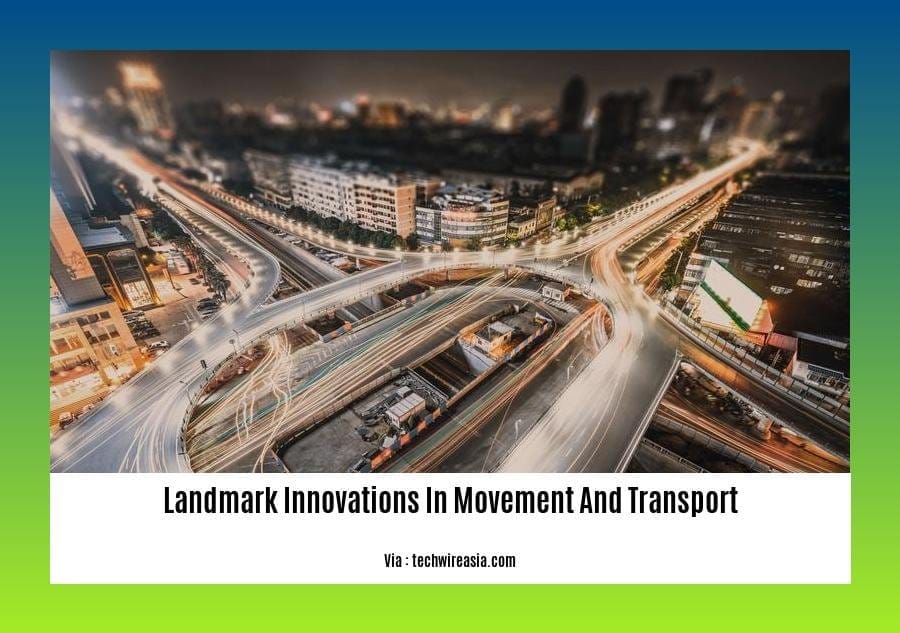Landmark Innovations in Movement and Transport: A Historical Overview. Discover the profound impact of technological advancements on the evolution of movement and transport.
Key Takeaways:

- Aerial observation balloons provided a new perspective for battlefield reconnaissance.
- The Gatling gun revolutionized infantry warfare with its rapid-fire capabilities.
- Unmanned aerial vehicles (UAVs) transformed surveillance and warfare.
- Armored ships introduced a new level of protection and firepower at sea.
- Railroads enhanced military logistics by enabling the swift deployment of troops and supplies.
Landmark Innovations in Movement and Transport: A Historical Overview
Throughout human history, landmark innovations in movement and transport have spurred revolutions, connected civilizations, and shaped our very existence. From the invention of the wheel to the development of the airplane, these advancements have forever altered the way we travel, explore, and interact with the world around us.
Early Innovations: The Seeds of Progress
The invention of the wheel around 3500 BCE marked the dawn of transportation, enabling the creation of carts and chariots for long-distance travel. This innovation laid the foundation for the development of more sophisticated vehicles and paved the way for trade and exploration.
The harnessing of wind power through sails around 4000 BCE allowed for the development of seafaring vessels. This innovation expanded trade horizons, facilitated cultural exchange, and opened up new possibilities for exploration and conquest.
The introduction of the stirrup to horse riding around 500 CE enhanced cavalry and riding efficiency. This innovation revolutionized warfare, providing greater stability and control to mounted soldiers.
The Industrial Revolution: A Surge of Advancements
The advent of the steam engine in the 18th century revolutionized land and sea travel. Steam-powered locomotives enabled the development of railroads, facilitating the mass movement of people and goods, while steamships reduced travel times and opened up new trade routes.
The 20th Century: An Era of Unprecedented Innovation
The automobile, developed in the late 19th century, provided personal mobility and transformed urban planning. The airplane, invented in the early 20th century, ushered in the era of air travel, connecting continents and shrinking distances.
The invention of the jet engine in the mid-20th century revolutionized air travel again, enabling faster, longer-range flights. This innovation made global travel more accessible and expanded the reach of military operations.
The Modern Era: Towards Sustainable and Intelligent Transportation
In recent decades, high-speed rail technology has emerged, enabling trains to reach speeds approaching 300 mph. This innovation has significantly reduced travel times for medium-distance journeys and offers a more environmentally friendly alternative to air travel.
Electric vehicles, developed in the 21st century, address environmental concerns and promise cleaner, more sustainable transportation. These vehicles reduce carbon emissions, promote energy independence, and contribute to improved air quality.
Autonomous vehicles, powered by advanced sensor and AI technologies, are paving the way for self-driving cars. This innovation holds the potential to enhance safety, reduce traffic congestion, and provide greater convenience. As technology continues to advance, it is likely that we will witness even more groundbreaking innovations in movement and transport, further transforming the way we interact with the world around us.
To truly understand how far the transportation industry has come, it is important to acknowledge the innovators who transformed transportation and mobility and the pioneers who revolutionized travel and transit. Without their dedication and vision, we would not have the advanced modes of transportation we rely on today. From the invention of the automobile to the development of high-speed rail systems, these transportation pioneers behind mobility breakthroughs have shaped the way we move and connect with the world around us.
20th Century Advancements
The 20th century witnessed a series of groundbreaking innovations that revolutionized movement and transport, transforming our world in numerous ways.
The Automobile:
The automobile emerged as a pivotal innovation, providing personal mobility and reshaping urban planning.
The Airplane:
The invention of the airplane ushered in the era of air travel, bridging continents and shrinking distances.
The Jet Engine:
The advent of the jet engine revolutionized air travel, enabling faster, longer-range flights.
The Rise of Mass Transit:
In major cities, urban transit systems expanded, including railroads and horse-drawn carriages, enhancing accessibility and mobility.
Long-Distance Connections:
Transcontinental and transoceanic passages improved long-distance communication, facilitating trade and exploration.
Transportation and Remote Areas:
New transportation lines extended into remote areas, contributing to their development and economic growth.
Key Takeaways:
- 20th Century Advancements: The automobile, airplane, and jet engine led to significant advancements in movement and transport.
- Urban Transit: Mass transit systems expanded in major cities, enhancing mobility.
- Long-Distance Communication: Improved long-distance communication facilitated global connectivity.
- Remote Area Development: Transportation lines extended into remote areas, contributing to their growth.
Citation:
- “History of Technology: Transport, Communications, Innovation.” Encyclopedia Britannica,
Modern Era
Movement and transportation have undergone a transformation in the Modern Era, characterized by revolutions in high-speed rail, electric vehicles, and autonomous technology. Let’s delve into these advancements and their impact.
High-Speed Rail: Shrinking Distances
High-speed rail networks have emerged as a game-changer for medium-distance travel, slashing journey times and bridging geographical gaps. Trains soaring at speeds of up to 300 mph have made intercity travel a breeze, boosting mobility and connectivity.
Electric Vehicles: Greener Odysseys
The rise of electric vehicles has sparked a shift towards environmentally conscious transportation, reducing carbon emissions and promoting cleaner air. Electric cars offer lower running costs and contribute to a greener future, paving the way for sustainable mobility.
Autonomous Vehicles: The Future Unraveled
Autonomous vehicle technology represents the frontier of transportation, promising self-driving cars that enhance safety, reduce congestion, and revolutionize mobility. Advanced sensors and AI algorithms are unlocking the potential for driverless vehicles, opening up new possibilities for commuting, logistics, and personal transportation.
Key Takeaways:
- High-speed rail networks enable swift and efficient medium-distance travel.
- Electric vehicles promote sustainability by reducing carbon emissions.
- Autonomous vehicle technology holds the key to safer, more convenient, and transformative transportation systems.
Citation:
– Transport Geography: Emergence of Mechanized Transport Systems
Impact of Innovations
Throughout history, impactful innovations in movement and transport have transformed societies, economies, and cultures. From the invention of the wheel to the development of jet engines and autonomous vehicles, these advancements have facilitated trade, expanded mobility, driven economic growth, and enhanced our understanding of the world.
Early Innovations
The invention of the wheel enabled the creation of carts and chariots, revolutionizing transportation. The sail harnessed wind power for seafaring, expanding trade and exploration. The stirrup enhanced horse riding, improving cavalry efficiency.
Industrial Revolution
The steam engine paved the way for locomotives and steamships, drastically reducing travel times. The railroad system transformed land transportation, enabling the mass movement of people and goods.
20th Century Advancements
The invention of the automobile provided personal mobility and reshaped urban planning. The airplane ushered in the era of air travel, connecting continents and shrinking distances. The jet engine revolutionized air travel, enabling faster, longer-range flights.
Modern Era
High-speed rail technology reduces travel times for medium-distance journeys. Electric vehicles address environmental concerns, promoting cleaner and more sustainable transportation. Autonomous vehicles promise greater safety, convenience, and efficiency.
Key Takeaways:
- Enhanced Mobility: Innovations in movement and transport have expanded accessibility and mobility, connecting people and places.
- Economic Growth: These advancements have boosted economic growth through trade, job creation, and increased productivity.
- Cultural Impact: Technological innovations have shaped cultural practices, including travel, tourism, and the exchange of ideas.
- Scientific Exploration: Improved transportation has enabled scientific explorations, facilitating groundbreaking discoveries and broadening our understanding of the world.
- Environmental Sustainability: Modern innovations, such as electric vehicles, aim to reduce environmental impact and promote sustainable practices in movement and transport.
Most Relevant URL Source:

FAQ
Q1: What were some of the key innovations that revolutionized battlefield tactics?
Q2: How did the Industrial Revolution impact the development of transportation systems?
Q3: What are the key characteristics of modern transport innovations?
Q4: How do innovation research models explain the dynamics of transport innovation?
Q5: What was the significance of railroads in the 19th-century transportation revolution?
- Unlock Black Pepper’s Secrets: A Complete Guide - April 26, 2025
- Discover Long Black Pepper: Flavor & Health Benefits - April 25, 2025
- Shocking Twists: The Grownup Review: Unreliable Narration - April 25, 2025
















